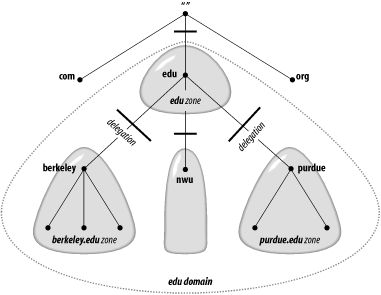Name Servers and Zones
The programs that store information about the domain namespace are called name servers. Name servers generally have complete information about some part of the domain namespace, called a zone, which they load from a file or from another name server. The name server is then said to have authority for that zone. Name servers can be authoritative for multiple zones, too.
The difference between a zone and a domain is important, but subtle. All top-level domains and many domains at the second level and lower, such as berkeley.edu and hp.com, are broken into smaller, more manageable units by delegation. These units are called zones. The edu domain, shown in Figure 2-8, is divided into many zones, including the berkeley.edu zone, the purdue.edu zone, and the nwu.edu zone. At the top of the domain, there’s also an edu zone. It’s natural that the folks who run edu would break up the edu domain: otherwise, they’d have to manage the berkeley.edu subdomain themselves. It makes much more sense to delegate berkeley.edu to Berkeley. What’s left for the folks who run edu? The edu zone, which contains mostly delegation information for the subdomains of edu.

Figure 2-8. The edu domain broken into zones
The berkeley.edu subdomain is, in turn, broken up into multiple zones by delegation, as shown in Figure 2-9. There are delegated subdomains called cc, cs, ce, me, and more. ...
Get DNS on Windows 2000, Second Edition now with the O’Reilly learning platform.
O’Reilly members experience books, live events, courses curated by job role, and more from O’Reilly and nearly 200 top publishers.

